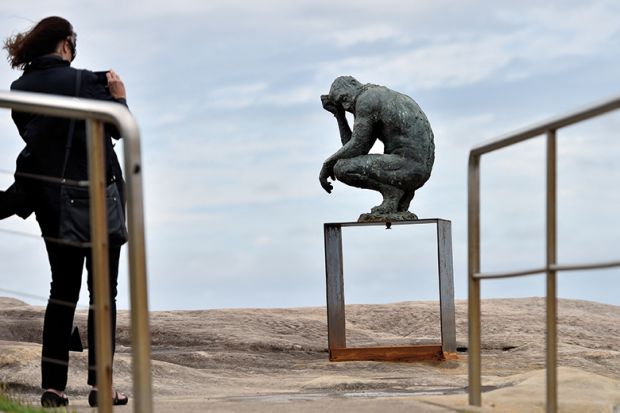Australian research into the impact of digital transformation on university workers has uncovered a “terrible climate for mental health”, with the “psychosocial safety” of more than two-thirds of staff at high or very high risk.
A four-year study has found that stress, exhaustion and burnout are endemic in universities and getting worse. In 2023, 73 per cent of surveyed staff were at high or very high risk for “mental injury stemming from work conditions”, up from 62 per cent in 2020.
Overall, 44 per cent of respondents claimed to experience frequent symptoms of psychological distress such as tiredness, anxiety and depression. Sixty-six per cent reported high or very high “emotional exhaustion” and up to 90 per cent reported excessive work pressures.
The findings, gleaned from almost 6,300 survey responses between 2020 and 2023, were due to be unveiled during a Perth conference. “The university sector is letting its staff down,” the researchers report. “The responses to questions on work pressure in the sector are damning.”
Lead investigator Kurt Lushington acknowledged potential selection bias in the results, but said the responses from participants recruited through three different mechanisms – university management, social media and the academic union – had been broadly similar.
The deteriorating pattern had also proved consistent, with the results worse in each successive year across both the entire sample and the 500-odd participants who had answered all four surveys.
Professor Lushington, professor of psychology at the University of South Australia (UniSA), said universities could not afford to ignore the findings. “If [they] don’t address these issues, it’s going to get worse.”
Co-lead investigator Maureen Dollard, director of UniSA’s Psychosocial Safety Climate Observatory, said mental distress was more acute in universities than in most other workplaces.
She said her centre’s 2023 survey of 10,000 workers across multiple professions had found that 54 per cent of respondents were working in low-risk psychosocial environments. In universities, the figure was just 18 per cent. That study ranked tertiary education as the fifth worst of 53 occupational groupings for psychosocial safety.
“Universities have operated a bit like a corporation for profit, focusing on buildings and top-end salaries,” Professor Dollard said. “We [need] more focus on the psychological health and well-being of the workers.”
Professor Dollard said universities should be obliged to report on psychosocial safety, which should be a key performance indicator for management salaries and enterprise agreements. Universities’ workplace health arms should also be “separated” from human resources departments, whose primary function was to support management rather than workers.
The surveys found that 69 per cent of respondents lacked time to “get the job done”, with 63 per cent saying email volumes were “overwhelming”. Headaches were familiar experiences for 30 per cent of respondents, muscle soreness for 37 per cent and neck or back pain for 49 per cent.
Thirty-seven per cent said they felt that “my work controls me”, and 35 per cent said student evaluations were a source of “dread”. Expectations of working “very fast” and “very hard” were reported by 81 per cent and 90 per cent respectively.
Professor Lushington acknowledged that workers in many industries faced similar expectations. “Academia has been accused of being a sheltered workshop for the academically gifted,” he noted. “But we’re talking about balance. Are the demands of the job realistic?”
He said it was particularly concerning that university staff’s mental health had continued to deteriorate despite a general “sigh of relief” after Covid lockdowns. One explanation was that administrators had not adequately replaced staff who had been shed during the pandemic, sometimes opportunistically.
“There hasn’t been a reinvestment in people, by and large. And if there has been, it probably hasn’t been directly at the chalk face.”
Register to continue
Why register?
- Registration is free and only takes a moment
- Once registered, you can read 3 articles a month
- Sign up for our newsletter
Subscribe
Or subscribe for unlimited access to:
- Unlimited access to news, views, insights & reviews
- Digital editions
- Digital access to THE’s university and college rankings analysis
Already registered or a current subscriber? Login










